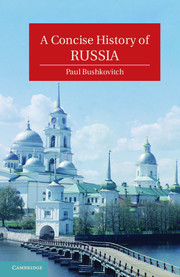Book contents
- Frontmatter
- Contents
- List of Figures
- Abbreviations
- Acknowledgments
- Prologue
- 1 Russia before Russia
- 2 Moscow, Novgorod, Lithuania, and the Mongols
- 3 The Emergence of Russia
- 4 Consolidation and Revolt
- 5 Peter the Great
- 6 Two Empresses
- 7 Catherine the Great
- 8 Russia in the Age of Revolution
- 9 The Pinnacle of Autocracy
- 10 Culture and Autocracy
- 11 The Era of the Great Reforms
- 12 From Serfdom to Nascent Capitalism
- 13 The Golden Age of Russian Culture
- 14 Russia as an Empire
- 15 Autocracy in Decline
- 16 War and Revolution
- 17 Compromise and Preparation
- 18 Revolutions in Russian Culture
- 19 Building Utopia
- 20 War
- 21 Growth, Consolidation, and Stagnation
- 22 Soviet Culture
- 23 The Cold War
- Epilogue
- Further Reading
- Index
16 - War and Revolution
Published online by Cambridge University Press: 05 June 2012
- Frontmatter
- Contents
- List of Figures
- Abbreviations
- Acknowledgments
- Prologue
- 1 Russia before Russia
- 2 Moscow, Novgorod, Lithuania, and the Mongols
- 3 The Emergence of Russia
- 4 Consolidation and Revolt
- 5 Peter the Great
- 6 Two Empresses
- 7 Catherine the Great
- 8 Russia in the Age of Revolution
- 9 The Pinnacle of Autocracy
- 10 Culture and Autocracy
- 11 The Era of the Great Reforms
- 12 From Serfdom to Nascent Capitalism
- 13 The Golden Age of Russian Culture
- 14 Russia as an Empire
- 15 Autocracy in Decline
- 16 War and Revolution
- 17 Compromise and Preparation
- 18 Revolutions in Russian Culture
- 19 Building Utopia
- 20 War
- 21 Growth, Consolidation, and Stagnation
- 22 Soviet Culture
- 23 The Cold War
- Epilogue
- Further Reading
- Index
Summary
The Russian revolution of 1917 was one of the many consequences of the First World War. The war placed strains on the Russian state and society that neither could withstand. The result was six years of war and upheaval that created the Soviet Union.
War
Russia's participation in the First World War was not an accident. After the Russo-Japanese War Russia's foreign policy turned west. In 1907 Russia concluded the treaty with its long time rival, Great Britain, to establish a condominium over Iran. The Russians took control of the northern part of the country down to Teheran, and the British the south. This compromise put an end to Anglo-Russian imperial competition in Asia, and meant that Russia was now effectively allied with Britain as well as France. The only imaginable enemies were Germany and Austria. The agreement over Persia set the stage for 1914, but it was imperial rivalries in the Balkans that provided the spark for the explosion. There, Russia faced a resurgent Ottoman Empire allied with Germany and Austria and Bulgaria tagging along. At this point Russia's only ally was tiny Serbia, which stood right in the way of Austro-German expansion in the south. A series of Balkan crises in these years repeatedly showed Russia's weakness in the area: it had no formal allies other than Serbia and none of the informal power that came from business ties established by the Germans and Austrians as well as the French and British. When Gavrilo Princip assassinated the Austrian archduke in Sarajevo in 1914, Vienna issued an ultimatum to Serbia and Russia had to back up Serbian resistance. Russia's basic credibility was at stake, and the result was war. It had not sought the war, but had drifted into the crisis as it was doing in so many other areas.
- Type
- Chapter
- Information
- A Concise History of Russia , pp. 293 - 317Publisher: Cambridge University PressPrint publication year: 2011

